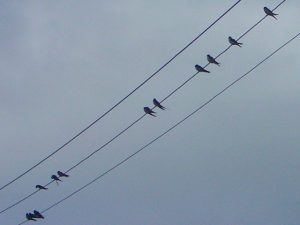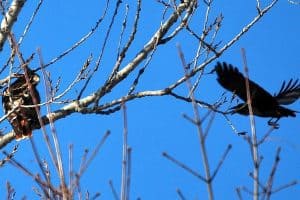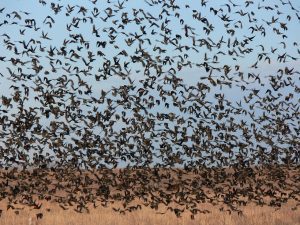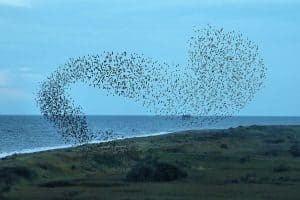Flocking provides many benefits but questions remain
“How early in the year it begins to be late” Henry David Thoreau
Nature plays a cruel joke on us in early July. Just as summer is getting started, intimations of autumn can already be seen. One such sign is the formation of flocks in some birds. In the city, large congregations of European starlings will soon be roosting in shade trees and advertising their presence by their clamorous calls and frequent flights from one tree to the next. In local wetlands, red‑winged blackbirds are flocking up and, by mid‑July, swallows will start to congregate on wires, especially around farms.
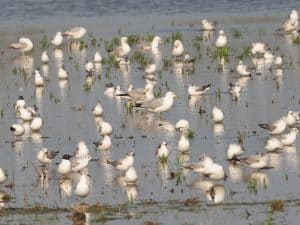
A flock of ring-billed and Bonaparte’s gulls at Hillman Marsh near Point Pelee National Park – Drew Monkman
Advantages of flocking
Flocking confers a number of advantages to birds. First, there is safety in numbers. By flocking together, the chance of any one individual being killed by a predator is lower than if the bird was by itself. With so many eyes watching, it is likely that at least some of the flock members will spot an approaching predator while other birds are busy feeding, sleeping or simply looking in the wrong direction. When predators attack a flock, they try to single out a bird on the edge of the group to pursue. However, once in flight, most flocks change shape constantly and both expand and contract in size. This makes it very difficult for the predator to remain focused on one bird. There is also evidence that it may be physically dangerous for a predator ‑ which may not be that much larger than the prey species it’s pursuing ‑ to dive into the middle of a fast flying mass of birds.
Flocking can also provide better access to food. After spending the night together in a communal roost, it is thought that birds gain information about good feeding resources by following older, more experienced individuals when they fly off to feed. This becomes especially important in the fall when food is erratically distributed and cooler weather, along with the demands of the approaching southward migration, mean energy requirements are higher.
Scientists have often wondered why older birds would want to share food information and potentially end up eating less themselves. It appears there is a worthwhile trade-off. In several species, it has been shown that older birds, being more dominant, actually appropriate the safest, most central locations in the roost while the younger, weaker birds are relegated to the edges. This exposes the less dominant birds to a greater danger of predation. The arrangement is advantageous for both groups ‑ older and stronger birds allow their weaker brethren to bear the brunt of predation while younger and weaker birds get to follow the others to good foraging sites.
Flocking also enables birds to expend less energy in flight. When the lead bird flaps its wings, it creates uplift for the birds behind. Each bird (except the leader) is flying in the up wash from the wing of the bird in front. This enables the flock to use less energy and reduces fatigue.
Mobbing and pishing
Although not technically flocks, birds will also congregate together to attack, chase or simply pester a predator. This is usually done to protect offspring. Known as ‘mobbing’, the behaviour includes flying around the intruder, dive bombing and calling or squawking loudly. The loud alarm calls also serve to summon nearby individuals to join the attack and drive the predator away. Mobbing is especially noticeable in crows, which can often be seen and heard pestering a cat, fox, owl or other predator.
Although mobbing may involve some risks, there are obviously benefits. All of the birds in the mob increase their chances of survival and reproduction. An individual on its own, however, would stand little chance against a predator. There is also research showing that crows may even place sentinels in trees to watch for possible predators. This is done so that other nearby crows can safely feed on the ground. When the sentinels start calling loudly, the feeding crows will either fly off or begin to mob the intruder. Don Finigan of Peterborough told me recently about a fox that makes regular visits to his yard to hunt squirrels. Each time, the fox’s arrival is announced by the raucous displeasure of the crows.
The mobbing reflex on the part of some birds explains the effectiveness of a birding technique known as ‘pishing’. It is used to bring birds in closer for better views. The raspy, rough quality of the pish sound birders make is similar to the alarm or scolding calls of small songbirds such as chickadees. Scientists believe that birds interpret the sound as that of another bird that has discovered a predator and is recruiting help. An alternative explanation is that some species of birds are simply curious and have evolved to investigate unknown noises.
To pish, choose a place where there is already some bird activity such as the calls of chickadees. Place yourself close to some trees or shrubs where the birds you attract can land. Pucker your lips and make a loud, forceful “shhhh” sound, while tacking a “p” on at the beginning: “Pshhhh, Pshhhh, Pshhhh”. Make sure the sound is shrill and strident. Do it in a sequence of three, repeating the sequence two or three times. At first, you’ll probably need to pish fairly loudly, but you can lower the volume once the birds get closer. Continue pishing for at least a couple of minutes after the first birds appear. This will give other species that may be present a chance to make their way towards you. Chickadees and nuthatches are especially receptive to the pishing sound, but other species like warblers, wrens, finches and sparrows will usually approach as well.
Quite often, the birds that are attracted by pishing are actually feeding together in loose flocks. For example, chickadees that glean insects from leaves, bark and punky wood are often found in the company of nuthatches, woodpeckers, kinglets and warblers that are searching for similar – but usually not identical – food items. Having more individuals searching for food increases the likelihood that a rich feeding patch will be located and food-poor areas can be avoided. Individuals probably also learn about new food sources from other species. In one study, titmice were observed visiting a site where a woodpecker was pecking at bark. It quickly began foraging in the same place. Mixed-flocks are most common outside of the breeding season.
Blackbirds
By mid‑July, most Red-winged blackbirds have finished breeding. Males lose their intolerance of one another and form feeding flocks, which roost together at night. Initially, these flocks are small and include only the adults and young of local breeding populations. However, as summer advances, these smaller roosts will begin to break up and much larger flocks form. A mixing of different species occurs, too, with common grackles and European starlings often joining in with the red-wings. The roosts are often cattail marshes, thick stands of alders or even upland woodlots.
Starlings and crows
For city dwellers, starlings and crows are usually the most noticeable roosting species during the summer months. Large deciduous shade trees are the preferred roosting sites. Thousands of starlings may occupy a given stand of trees and will sometimes return each night until the leaves drop. As sunset approaches, the birds start arriving in the vicinity of the roost and perch in nearby trees, often making frequent, noisy flights from one tree to another. This activity, known as staging, goes on for about half an hour before they actually settle into the roost trees. For nearby residents, the noise and commotion can be irritating to say the least.
Watching a flock of starlings take flight and then change directions simultaneously is fascinating. How does the group manage to turn and maneuver, almost as a single unit? As it turns out, the behaviour does not depend on the actions of any one “leader” but is rather a property of the group itself. The maneuvering of the flock, known as a murmuration, is determined by the second‑to‑second decisions of individual birds as they respond to what seven – yes, exactly seven – of their flock neighbours are doing. When one bird changes speed or direction, its seven closest neighbours do the same. In this way, the information spreads almost instantaneously across the flock. Google “flight of the starlings” to see a beautiful video of a murmuration filmed in the Netherlands.
Crows, too, often congregate in the hundreds or even thousands to sleep in communal roosts. An hour or two before darkness, they start flying to peripheral congregation sites, located close to the overnight roosting spot. There is usually a lot of noise-making, chasing, and general squabbling that goes on at these sites. Then, right at dark, the crows move on to their nearby final destination.
What to watch for this week
Young frogs are transforming into adults and leaving their natal ponds. Watch for tiny (less than one centimetre in length) wood frogs, spring peepers and American toads on moist areas of the forest floor from July through September. In backyards and parks, listen for the buzzy, electric song of the first dog-day cicadas of the summer.
